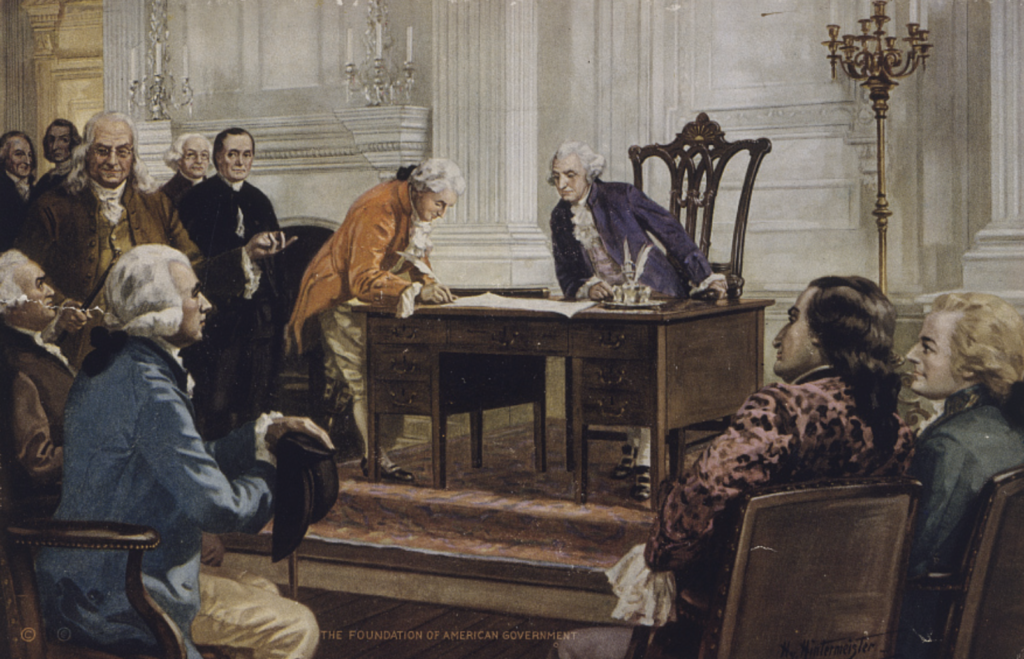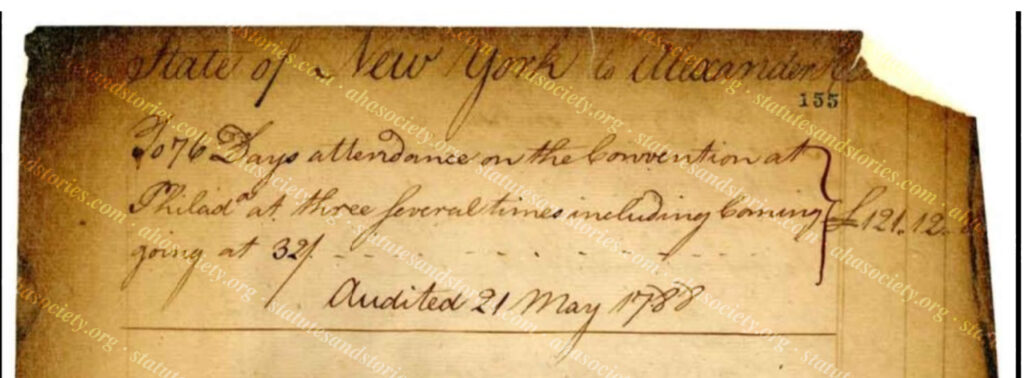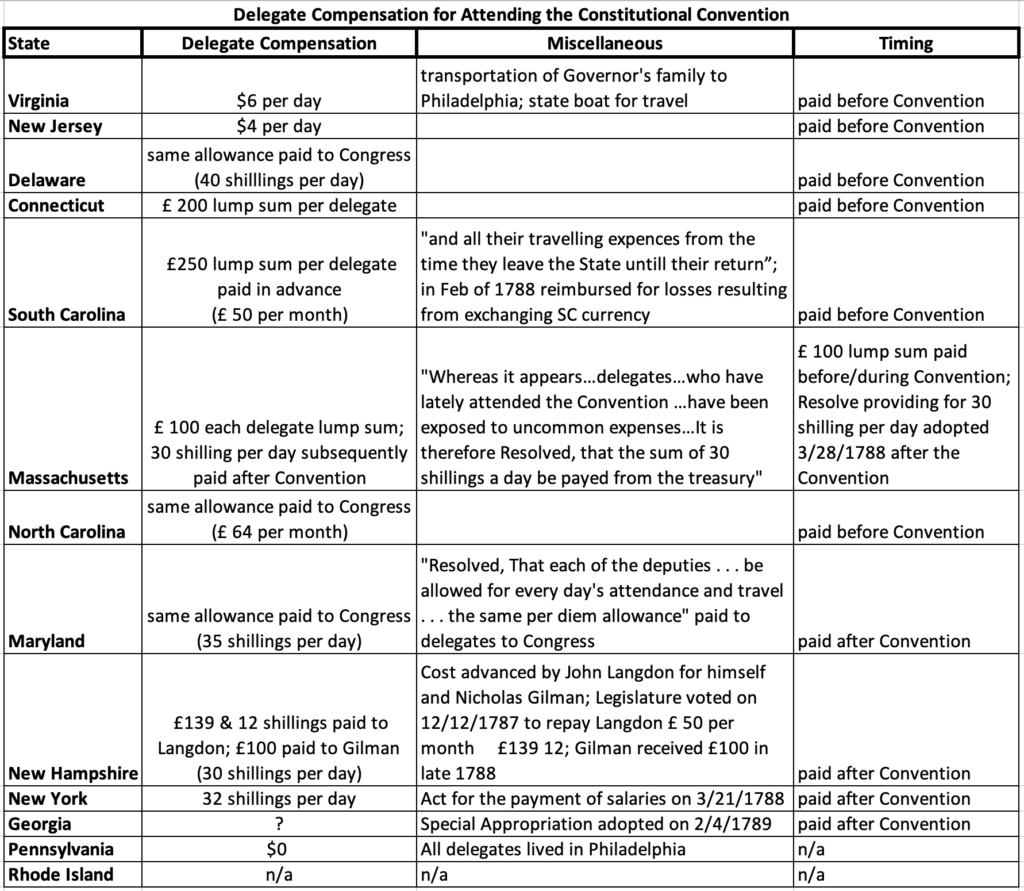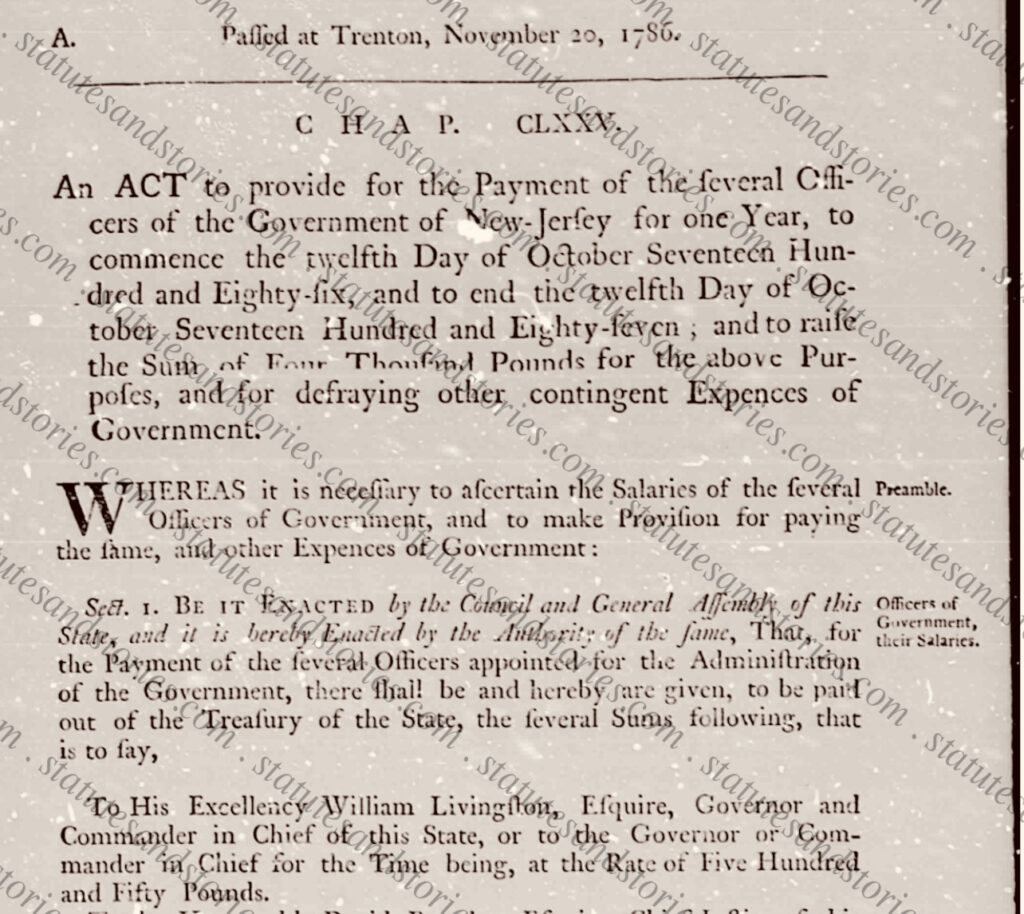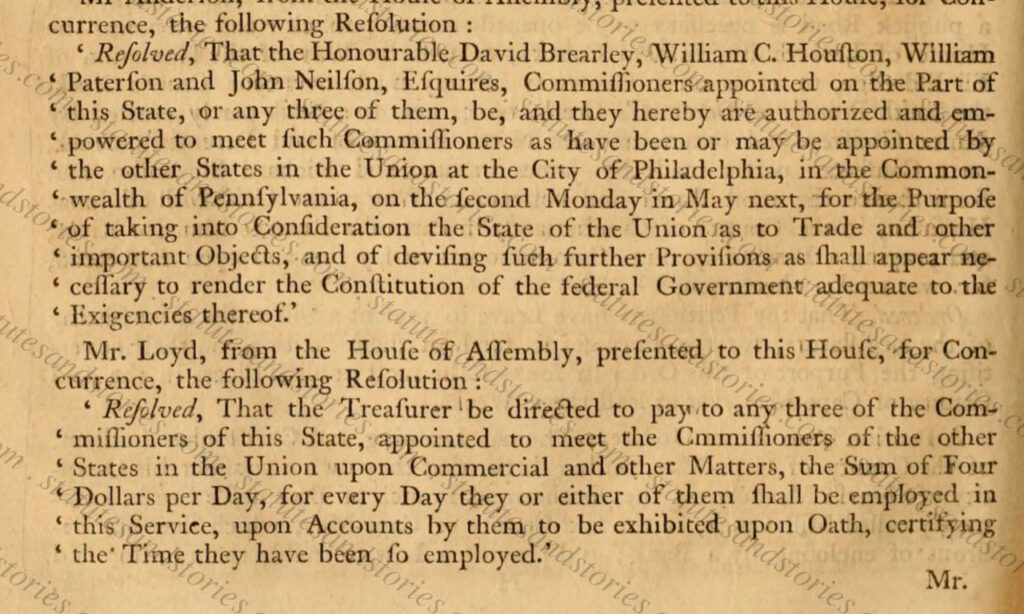Delegate Compensation and the Constitutional Convention and Why it Matters
When the fifty-five delegates attended the Constitutional Convention during the summer of 1787 they left behind their families, jobs and farms. Although Congress had called upon the states to send representatives to Philadelphia, the state delegations were not paid by Congress. Rather, it was up to each individual state to decide how many delegates to appoint and how they should be compensated, if at all.
This blog post – Part I – is part of a three-part series discussing delegate compensation in Philadelphia during the summer of 1787. Part I begins with a review of existing scholarship by historians who have concentrated on this seminal period in American history. After more than 230 years, historians have only been able to assemble an incomplete approximation of how a handful of states paid their delegates.
Yet, by collaborating with state archivists and using recently digitized records, a nearly complete picture emerges. By compiling these new available archival sources, the underlying financial incentives (and pressures) for delegates come into view.
Part I argues that by examining how different states paid their delegates it is possible to gain a better understanding of the subtle dynamics in play during the Constitutional Convention. New York provides a compelling case study. This research is synthesized in a newly released chart set forth below.
Part II (pending) reviews efforts by historians and biographers to “judge” the performance of individual delegates at the Convention. In particular, historians have commonly suggested that Alexander Hamilton’s performance in Philadelphia was “curious,” “disappointing,” or “inexplicable,” compared to his monumental efforts prior to – and after – the Convention. Part II pushes back on this view. Unlike the majority of other delegates in Philadelphia, Alexander Hamilton faced an uncertain prospect of being compensated by his hostile governor, George Clinton. In fact, recently discovered archival records prove that Hamilton was not reimbursed for the cost of attending the Convention until May of 1788. With a growing family of three young children to support, Alexander Hamilton simply did not have the same resources available to other delegations.
Part III (pending) provides additional state-by-state examples of the primary sources, including correspondence, receipts, financial ledgers, audits, statutes, legislative journals and resolutions that were used for this analysis. Part III contains links to permit others to dig deeper into the implications of this research, which may still yield additional fruit. Click on the following links for a discussion of compensation paid to delegates from New York, Virginia, and New Hampshire.
Indeed, during the Covid pandemic many research institutions opened their holdings by removing paywalls and otherwise waiving fees. In particular, Statutesandstories is grateful for the assistance of New York State Archivist, Thomas Ruller, and his staff, New Hampshire State Archivist, Brian Burford, and other unsung archivists in Connecticut, Georgia, and Massachusetts whose valuable assistance made Part III possible.
Existing scholarship and recent New York discoveries
To commemorate the 200th anniversary of the drafting of the Constitution in 1987, historians and researchers at Independence Hall and the National Park Service prepared the book, 1787: the day-to-day story of the Constitutional Convention. By compiling then available records and working with over three dozen contributors, the authors identified delegate compensation (or the lack thereof) in four states which they described as follows:
The Pennsylvanians, all from Philadelphia, didn’t get an expense allowance….The other eleven delegations did receive expense money – form $4 per day (New Jersey) to 40 shillings per day (Delaware) – paid by the state. Some of the states advanced expense money, other paid as soon as the delegates got home, and New Hampshire paid its delegates within a year.
In 2009 the late Richard Beeman wrote his authoritative account of the summer of 1787, Plain, Honest Men, which built on Catherine Drinker Bowen’s masterful work in Miracle at Philadelphia (1966). Among other things, Beeman surveyed the delegates’ dining habits, lodging, and personal correspondence. According to Beeman, “the question of payments of salary and expenses was hardly an abstract one for most delegates.”
Aside from Philadelphia’s summer climate, unpleasant odors, and aggressive pestilence, the most consistent source of private complaint from delegates was the poor state of their remuneration while toiling in the Assembly Room. Pennsylvania, whose delegates all came from the immediate Philadelphia vicinity, paid its delegates absolutely nothing for their nearly four months’ worth of work …. Delegates from the other eleven states attending the Convention received no salary but were compensated for a small portion of their expenses – ranging from four dollars per day for the New Jersey delegation to about six dollars per day for those from Delaware.
Professor John Vile’s exhaustive two volume work, The Constitutional Convention of 1787: A Comprehensive Encyclopedia of America’s Founding, contains an entire entry on the expenses of delegates. Vile agrees that Pennsylvania paid nothing to its delegates who lived in Philadelphia. Vile recounts that New Jersey paid $4 per delegates per day, while Virginia paid $6 per day. Vile also describes how New Hampshire’s two delegates, John Langdon and Nicholas Gilman, “would probably never have arrived had John Langdon not proved able to front the money for their expenses.”
Recent New York discoveries
Earlier this year, we discovered that in 1788 Alexander Hamilton and his co-New York delegates Robert Yates and John Lansing, Jr., were paid 32 shillings per day to attend the Constitutional Convention. Click here for a discussion of the significance of this discovery, which had been a mystery for over 230 years. For the reasons described below, New York was an outlier when compared to the other states.
The majority of states initially provided their delegates with funds when they departed for Philadelphia. By comparison, Hamilton, Yates and Lansing, were paid almost a year after the Constitutional Convention ended in September of 1787. In other words, the New York delegates were forced to cover their own expenses, assuming that they would be compensated at a future date. Part II (pending) argues that this was no accident. Rather, New York and its Anti-Federalist Governor were generally hostile to the mission of the Constitutional Convention. It is thus not surprising that New York’s delegates did not have the same financial resources that most of their other colleagues from other states enjoyed during the summer of 1787. Part III (pending) details discoveries outside of New York, which in several cases are also believed to be significant.
State comparisons
Twelve states sent delegates to the Constitutional Convention. Rhode Island was the only state to refuse to participate. Virginia played a leading role in calling for the convening of the Constitutional Convention which had been proposed by the Annapolis Convention. Virginia’s Act Authorizing the Election of Delegates was adopted on 23 November 1786. The highly influential act, written by James Madison, was sent to the other states and widely reported in the papers. Virginia further evidenced its support for the Convention when it appointed a seven-member delegation which included Virginia Governor Edmund Randolph, James Madison, leading jurist George Wythe, and arguably the most famous American, George Washington.
Pennsylvania hosted the Constitutional Convention in Philadelphia and appointed the largest state delegation of eight members. Pennsylvania’s most famous delegate was Benjamin Franklin, the only other American who may have been more beloved than George Washington. Interestingly, due to financial difficulties, Pennsylvania purposely selected delegates who lived in Philadelphia to avoid having to pay travel expenses. According to Professor John Kaminski, the selection of delegates who resided in Philadelphia was more politically motivated, than financial.
As discussed in Part II (pending), New York appointed three delegates, who were ultimately reimbursed in 1788. The smallest delegation was sent from New Hampshire, the northern most state at the time. Because New Hampshire was unable to pay its delegates, John Langdon covered the costs for himself and his co-delegate, Nicholas Gilman. Langdon would eventually be reimbursed in December of 1787. Georgia, the southernmost state, was unable to pay its delegates until a special appropriation was adopted in February of 1789. Primary sources from New Hampshire and Georgia are discussed in Part III (pending).
The chart below summarizes how the state delegations were paid. It is important to note, however, that at various times after the Revolutionary War seven states printed their own currencies. Thus, the monetary amounts in the chart are not necessarily equivalent. Likewise, it is not clear which states were using the British pound versus their own state currency.
It is also useful to recognize that different delegates attended the Convention at different times. For example, the Virginia delegates arrived early, prior to May 14, the scheduled commencement date for the Convention. Famously, James Madison and his Virginia colleagues were able to productively use the time to coordinate strategy with the Pennsylvania delegation while waiting for a quorum to finally arrive on May 25th. Historian Richard Beeman refers to this fortuitous event as “the delay that produced a Revolution.” At the very least it produced the Virginia Plan.
By contrast, New Hampshire finally got around to appointing delegates on June 27, after the Convention was already underway. New Hampshire delegates John Langdon and Nicholas Gilman eventually arrived on July 23. Other examples of late arrivals include Daniel Carroll of Maryland who first arrived on July 9 and John Francis Mercer of Maryland who arrived on August 6. Click here for a link to the dates of delegate attendance prepared by Max Farrand.
When comparing delegate compensation it is also important to recognize that some delegates were already receiving salaries when they attended the Convention. For example, Virginia Governor, Edmund Randolph, and New Jersey Governor, William Livingston, received salaries of £ 800 and £ 550 pounds, respectively. Similarly, New York Supreme Court Justice, Robert Yates, received a salary of £ 500 pounds. The evidence discussed in Part III (pending) suggests that these state officials received their salaries along with the separate per diem available to other Virginia ($6 per day) and New Jersey ($4 per day) delegates. It also appears that the State of Virginia arranged to transport Governor Randolph’s family by “vessel” to Philadelphia. The same arrangements were also available for other Virginia delegates whose families resided in Williamsburg (Blair and Wythe).
Copied below is New Jersey’s annual Act to provide for payment of governmental salaries. The law provided that Governor Livingston’s salary in 1787 was £ 550. Also pictured below is an excerpt from the Journal of the Legislative Council of New Jersey, containing a Resolution specifying that New Jersey’s commissioners were to be paid $4 per day. As the Convention approached, New Jersey adopted a second Resolution specifying that Governor Livingston was also entitled to collect the same $4 per diem as the other New Jersey delegates. This legislation is discussed in Part III (pending).
Individual delegates varied enormously in their personal financial situations. For example, Robert Morris was likely the wealthiest American at this time. For Morris, who owned the biggest mansion in Philadelphia, the lack of a daily per diem from the State of Pennsylvania was irrelevant. In fact, Morris insisted that George Washington stay with him during the Convention, rather than residing at a boarding house with James Madison and the other Virginians. It is also noteworthy that many southern plantation owners may not have been liquid, but were some of their state’s wealthiest individuals, nonetheless.
George Mason is a good example. Mason brought at least two of his more than 300 slaves with him to Philadelphia. In a letter to his son, Mason observed that the cost of living in Philadelphia was cheap enough that he would be able to cover his expenses with his $6 per day per diem from Virginia. Significantly, Mason’s costs included the stabling of his horses and carriages, along with lodgings for his “servants.” According to Mason’s letter dated May 20 to his son, George Mason, Jr.:
In this city the living is cheap. We are at the old Indian Queen in Fourth Street, where we are very well accommodated, have a good room to ourselves, and are charged only twenty-five Pennsylvania currency per day, including our servants and horses, exclusive of club in liquors and extra charges; so that I hope I shall be able to defray my expenses with my public allowance, and more than that I do not wish.
This post continues in Part II (pending) with a discussion of how historians have attempted to “rate” the performance of individual delegates. While this exercise is instructive (for what it’s worth), Part II argues that delegate compensation is a necessary component of any comprehensive analysis. Alexander Hamilton, unlike many delegates, was not independently wealthy. Indeed, in 1787 he left behind three young children and a busy law practice when he attended the Convention in May and June. Part II argues that unlike co-delegates from New York, Hamilton was not paid a salary by New York State. Accordingly, any assessment of Hamilton’s attendance at the Convention should properly contextualize the financial incentives different states provided to their delegates during the four months of the Convention.
Additional reading and sources:
The Records of the Federal Convention of 1787, Vol III, edited by Max Farrand (1911)
Plain, Honest Men: The Making of the American Constitution, Richard Beeman (2009)
Miracle at Philadelphia, Catherine Drinker Bowen (1966)
A Brilliant Solution: Inventing the American Constitution, Carol Berkin (2002)
The Summer of 1787: The Men Who Invented the Constitution, David O. Stewart (2007)
